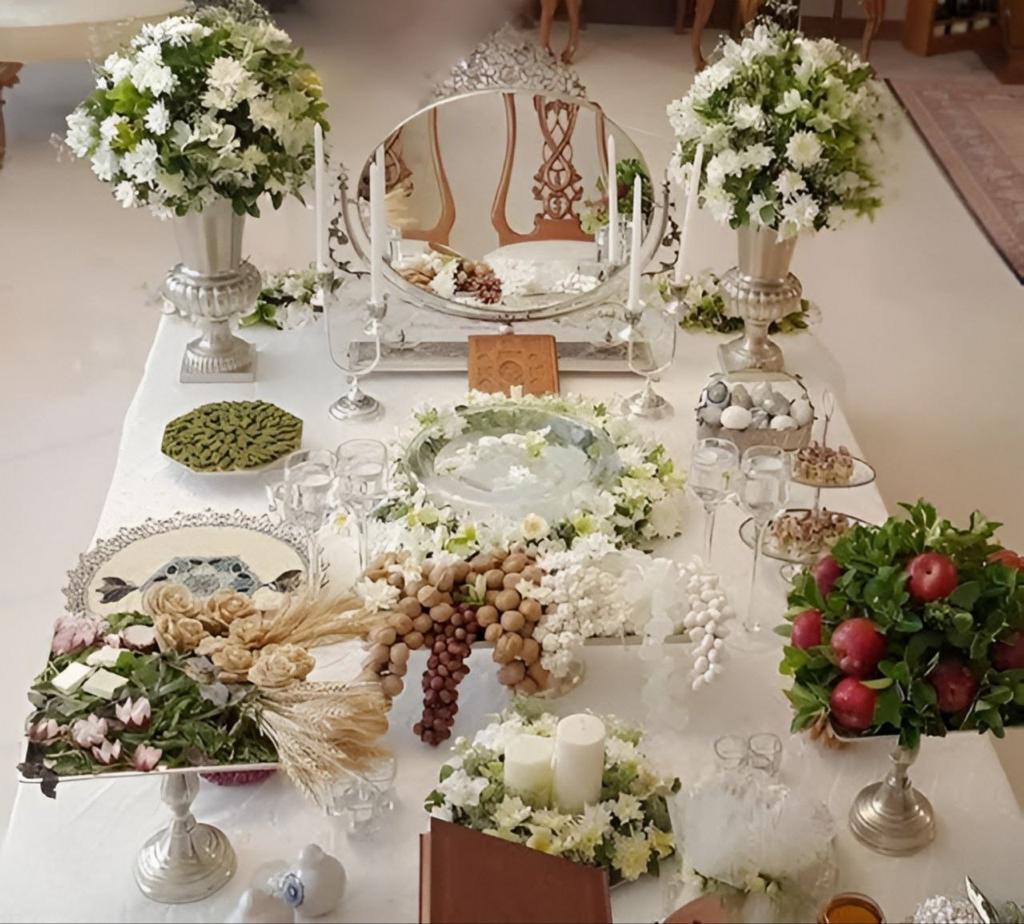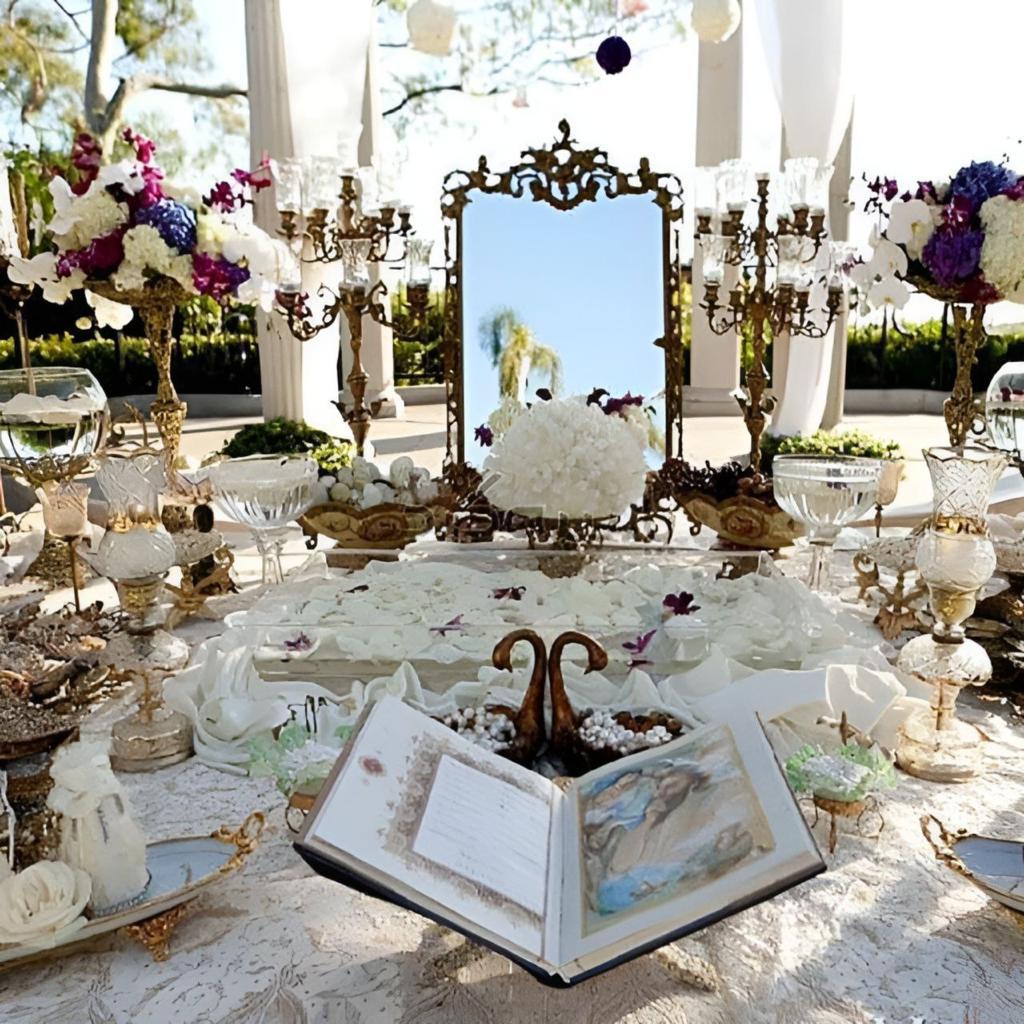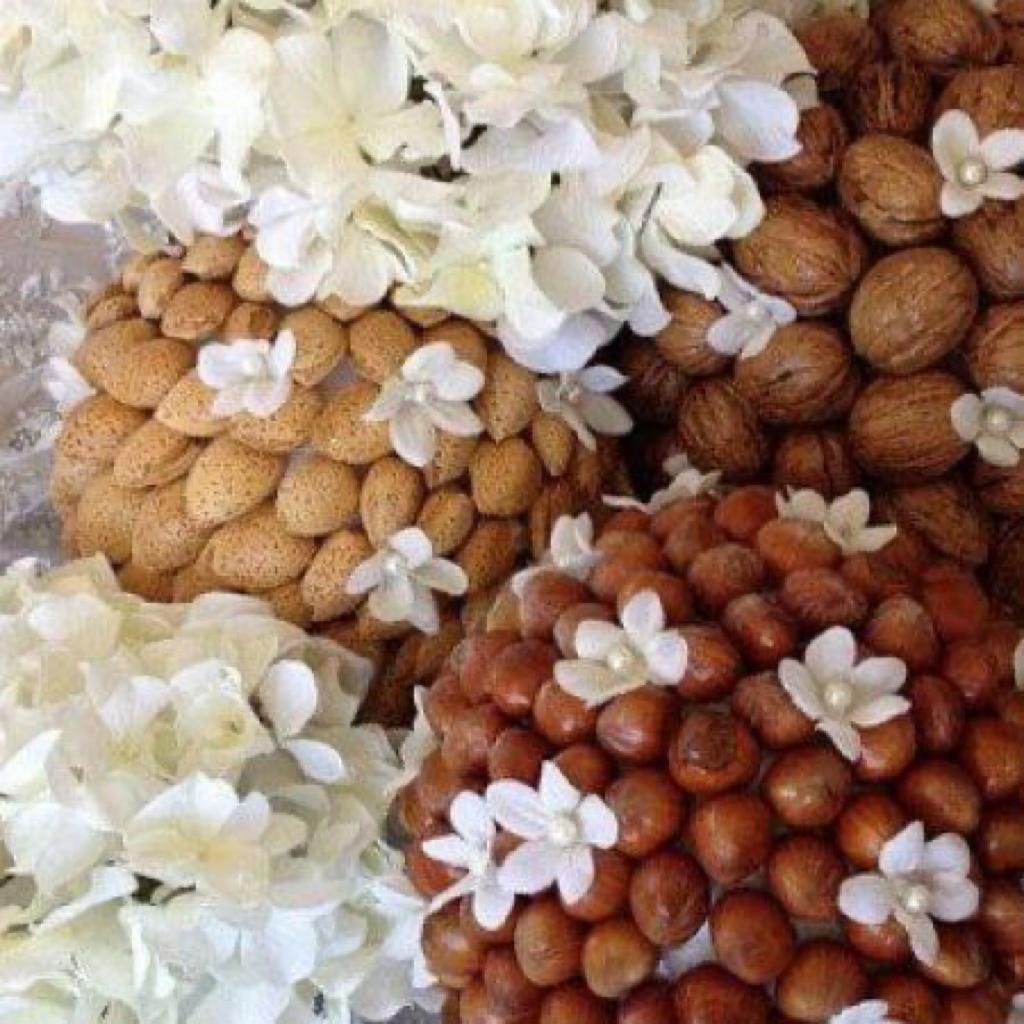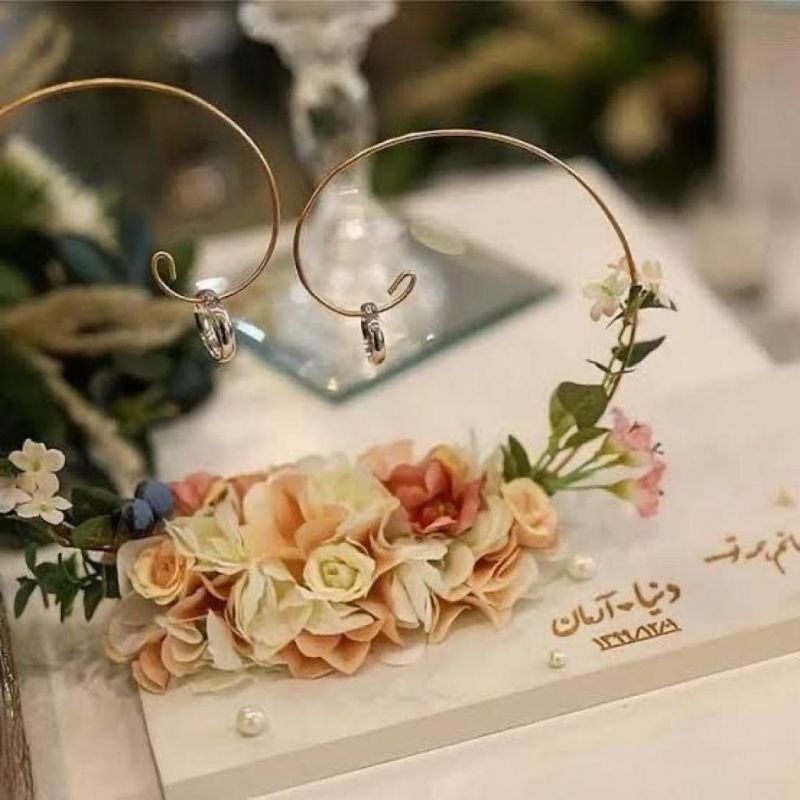In Iran, as in every country, there are unique wedding customs, rituals, and traditions, most accompanied by dances and specified music at the right moment. The event scenario and the wedding custom, rich in its traditional significance, has a millennia-long history. Although there are differences in wedding rituals among the various ethnic groups in the country but all of them have common roots, as Iranians claim themselves in their historical books.
I was fortunate to be invited to one of the modern Iranian weddings in the suburbs of Tehran, and following the Pushkin's poem “And I was there, drank honey&beer”. Of course, everything described bellow is based on Iranian canons, and about 60% exist really today while the remaining 40% are transformed and modernized but have not disappeared. And that's wonderful!
Courtship or betrothal (“khastegari") is the foremost custom in beginning the journey to create a new family. Observing this custom the groom with his family visits to the bride's house and both families get to know each other. In the distant past families were used to selecting a girl and a boy for getting marriage and during this “khastegari" they were acquainted themselves and then they presented the possible couple to each other. However, todays the youths get to know each other first, i.e. initially the young couple meets and only afterwards, as everywhere, their families get acquainted according to the tradition.

During this acquaintance “khastegari" the families reach an agreement following the custom called “baleborun”. In Russian dictionaries this word is translated as engagement, but this interpretation was likely proposed in the course of events in Russian wedding culture: the engagement followed the courtship. In reality this is quite stretched and the literal translation to Russian is rather conditional. During this custom in Iran the most elder members of both families get together and settle matters regarding the so-called “mehrieh”, the date of marriage registration and the conduct of the actual wedding. In modern families it is no necessary to involve old people because the parents make the arrangements themselves. However, the reached agreements are still being putted in writing and confirmed by the signatures of the parties. Traditionally, at this event the groom's family presents the bride an engagement ring, wedding fabric for the chador, a wedding dress, a festive shawl and a bouquet of flowers, and also the groom's side sets the table with sweets. (Well, who would risk of choosing even color of the fabric or dress without prior agreement with the woman? Only a suicide...) So, the last statement is nearly real today. These are ordinary meetings, tea parties with discussing and planning the "events program".
The concept of "mehrieh" is indeed a specific item of Iranian wedding traditions. Mehrieh comes from the material world of things. For example, it can be small rectangular bar of gold, and its value depends on the price of gold per gram on the exchange. In 2022 one such bar was valued at $400 in specialized stores. During the ritual of courtship the elders discuss how much the man should pay or what he might leave for a wife in case of divorce or even just at the demand of the wife at any time on her whim. This tradition may seem strange, but it will provide the woman in case of separation. It's peculiar because in the conditions where Islamic form of governance prevailed in Iran many women “remembered” this right and demanded payment from their spouses. In cases of non-payment the spouses are to go to prison until the arrested person's relatives gather the required payment. It is said that at one period the number of those arrested exceeded tens of thousands, but this is likely a hearsay to spread fear, and it's not difficult to guess who the authors of such tales are and what their aims might be: let the men be fearful.. It’s too difficult to obtain truthful information in the Islamic Republic. However, based on open sources, today 2206 men are imprisoned for not paying mehrieh. Over an unspecified period, 4224 "non-payers" have been released. Therefore, it exists.

It sounds like "Mehrieh who gives, who takes?!" has become quite an iconic statement in response to the groom's claim that it's an archaism and doesn't need to be observed or register anymore. Nowadays this phrase has become famous in Iran. However the tradition of "Mehrieh" is unlikely to die out, as the quantity of mehrieh is a certain indicator, an estimation given for the marrying girl, and for the groom's family as an assessment of affluence and readiness to pay such a high price. This information can be proudly announced to the neighbors... The author was at the wedding where 98 gold coins mehrieh was agreed upon for the bride (count it yourself). By secular law, "Mehrieh" cannot be prohibited, but Iranian authorities have been concerned about the number of prisoner under this "act", when it's not alimony and could be a demand from the spouse resulting from a quarrel or just "feminine whim". That's why recently the law has defined the necessary amount of Mehrieh to be paid by the husband at the request of his wife not to be subject to arrest.
However the concept of “Mehrieh” isn't just gold coins. Mehrieh can be wife’s demand on the half an apartment or house or even instead of Mehrieh a woman may request that children live with her in case of divorce or she may envisage the freedom to travel abroad without the written consent of the husband, as there are such restrictions for women in Iran.
The "Agd Konan" is considered the third custom of the entire wedding ceremony. This is the legal and official procedure of marriage. Here we can see familiar elements of our weddings and engagements. But it most reminds a wedding and after the wedding the young couple becomes husband and wife аs the result. The "Agd Konan" is organized in the bride's father's house or in the "Mahzar" (a prototype of a marriage palace, like a registry office). Today in Iran the term "salon" is more frequently used. During the ceremony a prayer sermon called "Khotbe-e agd" about the conclusion of marriage is read and according to Sharia law and secular law they become husband and wife. It's read by a clergyman or a salon employee with the authority to seal the marriage (in other words, confirm the marriage). An essential requirement of this tradition is a specially set wedding table and decorated dishes. Family members, relatives, and the closest and most honorable friends are invited to the ceremony. The groom and the bride sit at the head of a wedding table, welcome the guests and await the arrival of the person who will read the prayer sermon and ask for their voluntary consent to get marriage. On the table, since ancient times - even from the time of Zoroastrianism - a mirror and a couple of candlesticks are set up. The mirror symbolizes destiny, while the two candlesticks symbolize light and fire. Moreover, when the bride enters the hall with her face covered with a veil, she sits next to the groom, removes the veil, and the first thing that the groom sees in the mirror should be the reflection of his future wife. In reality, there are multiple mirrors, reflecting and multiplying the light of flickering candles beautifully. Also on the table there are herbs, pastries, blessed bread with calligraphic inscriptions, bread with cheese and greens. Symbols of fertility are decorated eggs, almonds, walnuts, and hazelnuts. There are heavenly fruits for the Iranians too i.e. pomegranates, grapes and apples. Mandatory items include a bucket of honey, eastern sweets (various nuts in sugar glaze), gold and silver coins in the mentioned wooden dishes, lots of spices, flowers, saffron, ancient Iranian esfand powder, which Iranians throw into the fire to create fragrant smoke, ward off the evil eye, and fulfill wishes, and, of course, the Quran with a prayer rug.
Iranian wedding customs are indeed filled with rich and meaningful traditions. What truly sets apart the decoration of the wedding table in Iranian weddings is the inclusion of compilations of verses from their renowned poet (often Hafez). Each element of the table's adornment holds a symbolic, sacred meaning. It encompasses blessings, prosperity, joy, a sweet life, health and strength, a continuity of generations and general happiness. One of the most important and ancient traditions observed during the reading of the prayer sermon is the rubbing of sugar cones over the heads of the groom and the bride. During this ritual several young women hold a thin, beautifully decorated fabric over the marrying couple's heads while another woman (at the mentioned wedding, she was the very attractive sister of the bride) rubs the sugar cones over the fabric, aiming to shower the future life of the newlyweds with an abundance of happiness and delight. After the reading and the rubbing the groom and the bride spoon-feed each other honey in the hope of a sweet joint life, and they exchange engagement rings.
A few days after the "Agd Konan" ceremony the bride's family (now the lawful wife) invites the groom's family to lunch or dinner. The tradition's name "Pagosha" doesn't have clear translation. Two words constructs it by foot and open. In Iran familial bonds bring together many families, and the newlyweds should be present in each of these families entering their homes together.
The interpretation of Iranian wedding traditions encompasses various moments. Sometimes, several months may pass between the legal engagement and the actual celebration of marriage. Yet the newlyweds have the right to live together. If during this period occur certain celebrations such as the Iranian New Year (Nowruz) or the Yalda Night the groom's family is obliged to give gifts to the bride. Moreover, the bride's family is required to fully equip the newlywed couple's home, that is, for example, refrigerators, dishwashers, and so on. This commitment also has its own name "Jahiziye" or "Jahaz", in English translating - a dowry. However, in modern urbanized Iran not all of these customs are on duty.

A few days after the engagement and before the wedding "Jahazbaran" custom takes place: only women from the two united families visit the newlyweds' home and each of them brings gifts for the bride, as in the official description. In modern life, this issue usually involves presenting and installing appliances or equipment in a new house or apartment.
The "Hanabandan" celebration comes the night before the wedding, where makeup is applied to the bride. The "Hanabandan" (from the word henna) takes place in the house of the bride's father. The groom's family provides the party with fruits, sweets and decorative henna. At the end of meeting the newlyweds pick up henna and offer to distribute it to the guests at their request. Using henna demonstrates the rich significance of henna in the ancient culture of the Iranians. We can see henna in various forms in many ancient rituals, it symbolize different aspects of Iranian tradition. Henna became integral to Iranian culture long before the Islamic period. It continues to be a prevalent element in various rituals and ceremonies to this day.
And only after the "Hanabandan" celebration, the main event takes place - the wedding itself. It is organized in a hall or a garden with fountains, and it possibly would be at the groom's father's house. Guests are treated with fruits and sweets, and drinks that make us feel happier, relaxed and loving. Certainly it’s not public. A large number of guests due to the strong and extensive familial ties in Iranian families gets together in such events. But anyway it's always a private family celebration, often held on within a secluded garden venue behind high walls and under the diligent watch of perimeter guards. Respectful consideration is given to both compliance with restrictions and understanding someone's desire to bend them.
At the end of the wedding-party some guests might accompany the newlyweds to the ritual of bidding farewell to the bride's home. In this tradition the father places his daughter's hand in that of her husband and recites a prayer for their good fortune. They pass under the Koran and head towards their new home.
The following day the tradition of "Patakhti" obliges women from both families to present gifts to the newlyweds. However, if the new family has gone on their honeymoon these gifts must be presented upon their return.
Lastly, there's the custom that places the responsibility on the groom to thank the mother of the bride within a few days after the wedding and present her with a gift. It's aptly named "Mother-in-law, hello!" - "madar zan salam".
By this the dynamics between son-in-law and mother-in-law is likely to lead to an ideal relationship in the future but it surely will have inspired countless jokes and anecdotes in Iranian culture, much like in Russia. It's fascinating to see how these specific relationships find their way into the comedic net of societal narratives.


